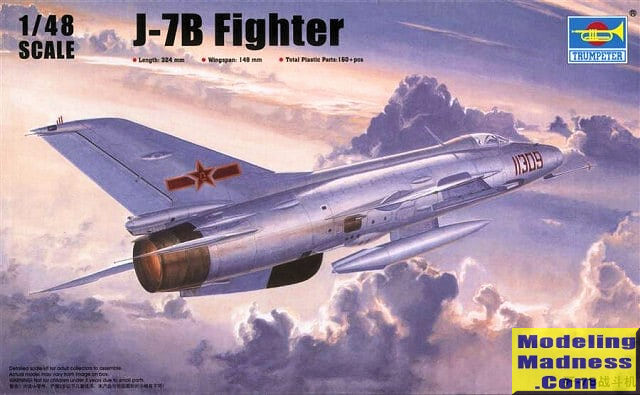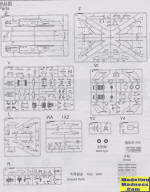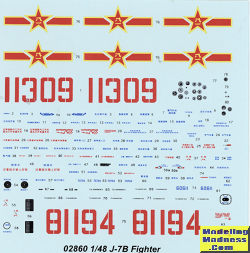
Trumpeter 1/48 J-7B Fighter
| KIT #: | 02860 |
| PRICE: | $25.00 or so |
| DECALS: | Two options |
| REVIEWER: | Scott Van Aken |
| NOTES: |
. |

| HISTORY |
Russian sources state that several complete examples of the MiG-21 were sent to China, flown by Soviet pilots, and China also received MiG-21Fs in kits, along with parts and technical documents. Just as the Chinese had expected, however, when the Soviets delivered the kits, parts and documents to Shenyang Aircraft Factory five months after the deal was signed, the Chinese discovered that the technical documents provided by the Soviets were incomplete and that some of the parts could not be used.
China set about to reverse-engineer the aircraft for local production, and in doing so, they succeeded in solving 249 major problems and reproducing eight major technical documents that were not provided by the Soviet Union. One of the major flaws was with the Hydraulics systems, which grounded up to 70% of aircraft in some squadrons until the systems were upgraded. Another major upgrade was modifications to the fuel storage to make the aircraft more stable. The MiG-21 carries most of its fuel in the forward fuselage, causing the center of gravity to shift and become unstable after about 45 minutes of operation. The J-7 has redesigned fuel tanks and significantly larger drop tanks in order to maintain a more stable center of gravity, and therefore better Longitudinal static stability. The cockpit was also revised to replace the Soviet ejection seat, which was found to be unacceptable. The forward opening canopy was replaced by a standard canopy hinged to the rear and jettisoned before the seat ejected. Otherwise, the re-engineering effort was largely successful, as the Chinese-built J-7 aircraft showed only minor differences in design and performance from the original Soviet MiG-21.
| THE KIT |
 There
are often odd reasons why people buy kits and I bought this one simply because I
needed parts from it for another build. You see, the J-7G that Trumpeter
produced only has parts for one cannon, and the option on a decal sheet I wanted
to build comes with two. Thanks to the wonders of modern modeling, the fuselage
halves are interchangeable, though there are a couple of holes that will need
filled/drilled.
There
are often odd reasons why people buy kits and I bought this one simply because I
needed parts from it for another build. You see, the J-7G that Trumpeter
produced only has parts for one cannon, and the option on a decal sheet I wanted
to build comes with two. Thanks to the wonders of modern modeling, the fuselage
halves are interchangeable, though there are a couple of holes that will need
filled/drilled.
Molding is excellent and whatever complaints one has about Trumpeter kits, they cannot really fault the quality of the molds. The box is pretty well packed with sprues and you won't use all the parts provided. I'm sure most of these bits are also applicable to the standard MiG-21F and the other J-7 versions. Interestingly, the build starts with the nose gear well. All of the gear wells (called 'cabins' in the instructions. have to be built up of many parts and I found it interesting that the color indicated for these is a light blue. Also interesting is that they provide no color at all for the cockpit or the bang seat. Photos on the Internet show it to be a pretty standard Russian blue-green shade or a sort of brownish light grey. I'd go with the previous.
There is a requirement for 10 grams of nose weight, which is actually quite a bit. A neat option is a detailed radio section under the upper nose panel, but most of us will simply glue the panel shut as it has no hinge and it adds space for weight. When one glues the fuselage halves, it traps both the intake shock cone and a built up tailpipe section. The fin has a separate rudder. The tail cone is a right and left half. I would have preferred this to be a single piece and Trumpeter should have the technology to make this so.
On the underside of the fuselage, there are a number of things to add. Both the forward and rear air brakes are separate and can be posed lowered. As mentioned, this kit has two cannon and their housings are also installed on the bottom.
Wings are upper and lower halves with a non-positionable slat. The ailerons and flaps are molded in with the wings. This is correct as you will not see these normally deflected when the plane is on the ground. These items are molded in with the upper wing halves. The single piece tailplanes just slot into the fuselage. Landing gear is well done as are the gear doors. The instructions have you install the nose gear at the very start of the build, but I'd see if this could possibly be delayed until near the end. All of the tires are rubber/vinyl so if you don't like using these, get aftermarket. The canopy, windscreen and rear section are separate, but shown installed in the closed position. The canopy opens to the right side so you can position it as such, though it will be a butt join.
 For things under wings we have
very little in the way of options. A pair of missiles for the wing pylons and a
centerline fuel tank are pretty much it. The early J/F-7s were quite basic
interceptors.
For things under wings we have
very little in the way of options. A pair of missiles for the wing pylons and a
centerline fuel tank are pretty much it. The early J/F-7s were quite basic
interceptors.
Instructions are well done with several paint options provided on the colors and markings sheet. Speaking of which, you are provided options for two white painted PLAAF aircraft and that is pretty much it. Decals are nicely printed, but seem a bit lacking in color density when you see them in person. Photos tend to strengthen colors. . A web search turned up nothing available to replace them.
| CONCLUSIONS |
Undoubtedly there is something 'seriously wrong' with this kit as the pundits are never really satisfied with what companies produce. However, the vast majority of us are not pundits and this looks like it will make into a very nice model when done.
October 2018
Copyright ModelingMadness.com. All rights reserved.
If you would like your product reviewed fairly and fairly quickly, please contact the editor or see other details in the Note to Contributors.
Back to the Main Page Back to the Review Index Page Back to the Previews Index Page